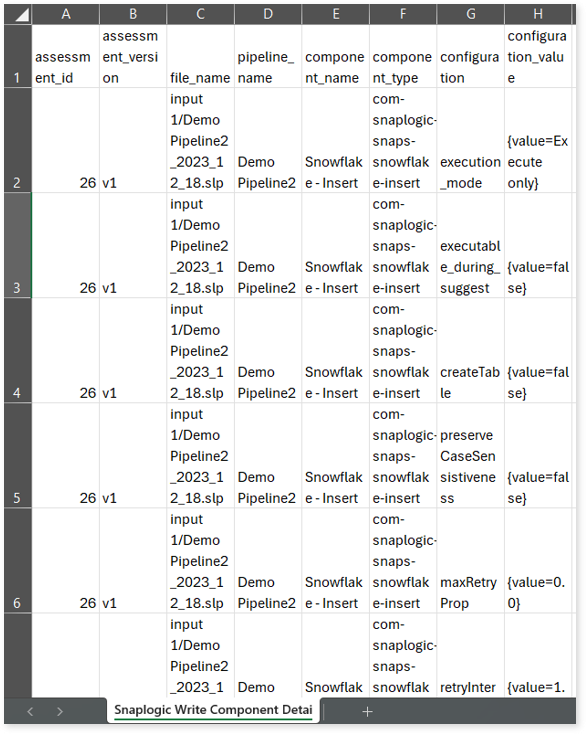SnapLogic Assessment Report
This topic contains information about the SnapLogic assessment report. The assessment assesses workloads and produces in-depth insights that help plan the migration. The input format for the SnapLogic assessment is SLP file format.
In This Topic:
Highlights
The highlights section gives you a high-level overview of your assessment summary of the analytics performed on the selected workloads. It includes an overview of queries as well as graphical depiction of the complexity of pipelines and queries.
Summary
This section provides an overview of input source files and the associated workload inventory including pipelines, components, queries, and more.

- Files: Displays the number of source files.
- Pipelines: Displays the number of pipelines existing in the source files. It is a data flow process to perform a specific task.
- Components: Displays the number of components existing in the input source files. Components serve as functional building blocks in the pipeline to perform a task.
- Queries: Displays the number of queries.
- Entities: Displays the number of entities.
- Missing Artifacts: Displays the number of missing artifacts.
Pipeline Complexity
This section provides a summarized graphical representation of pipeline complexity that helps in making different decisions, including budget estimation and the effort required for migration.
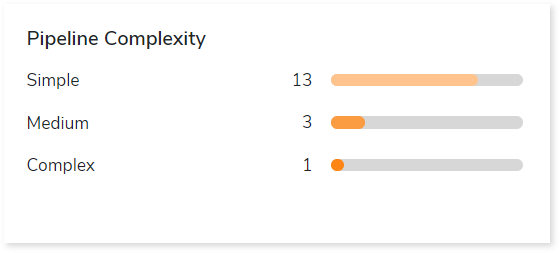
Queries
It displays a synopsis of analyzed queries along with information about unique, parsed, and unparsed queries.
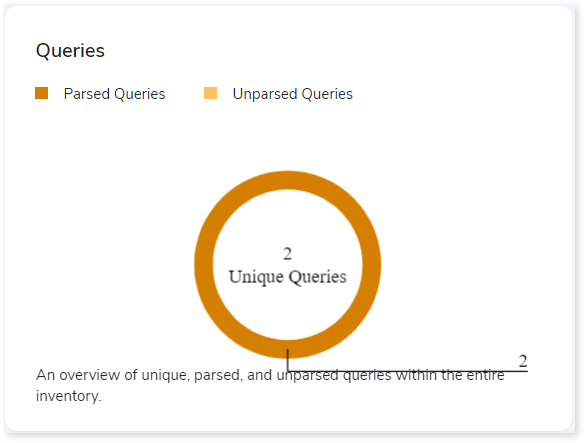
- Unique Queries: Displays the number of unique queries. In Unique Queries, duplicate queries are eliminated, and solitary queries are identified.
- Parsed Queries: Displays the number of parsed queries.
- Unparsed Queries: Displays the number of unparsed queries.
Query Complexity
This section provides a summarized graphical representation of the query complexity that helps in making different decisions, including budget estimation and the effort required for migration.

Analysis
This topic provides detailed information about source files, pipelines, queries, entities, and artifacts.
Files
This section provides a comprehensive report of the source files along with information about pipelines, transformations, procedures, and queries.

- File Name: Displays the name of the file.
- Pipelines: Displays the number of pipelines.
- Transformations: Displays the number of transformations.
- Procedures: Displays the number of procedures.
- Queries: Displays the number of queries.
Pipelines
This section provides detailed information about pipelines, including their components, queries, complexity, and associated files.

- Pipeline Name: Displays the name of the pipeline.
- File Name: Displays the associated file name.
- Components: Displays the number of components in each pipeline.
- Queries: Displays the number of queries in each pipeline.
- Complexity: Displays the pipeline complexity.
Browse through each pipeline to get more insights into the associated components.

- Component Name: Displays the name of the component.
- Types: Displays the type of the component.
- Source Name: Displays the associated source component name of each component. Source components feed data to the next component in the pipeline. For example, if a pipeline contains components A, B, C, and D which follow a sequential pattern to perform a task. In this case, A serves as the initial source component which feeds data to component B, and for B, C acts as the destination component. Similarly, B serves as a source component for C, and so on. This data flow from one component to another facilitates efficient data processing and transformation in the pipeline.
- Destination Name: Displays the associated destination component name of each component. The destination component receives data from upstream components in the pipeline.
- Execution Mode: Displays the execution mode of each component. The execution mode includes:
- Validate & Execute: Perform validation and execution on a specific component.
- Execute Only: Perform only validation on the specific component.
- Disabled: Disable or inactive the specific component in the pipeline.
Queries
This section provides detailed information about queries segregated into unique, analyzed, and not-analyzed queries.
Unique Queries
This section displays a list of all unique queries along with the total number of unique queries. In Unique Queries, duplicate queries are eliminated, and solitary queries are identified.

- File Name: Displays the file name associated with the query.
- Pipeline Name: Displays the name of the pipeline associated with the query.
- Component Name: Displays the name of the component associated with the query.
- Source Type: Displays the type of the source component associated with the query.
- Query Type: Displays the query type.
- Complexity: Displays the query complexity.
Analyzed
This section displays a list of all queries that meet the analysis criteria.

- File Name: Displays the file name associated with the query.
- Pipeline Name: Displays the name of the pipeline associated with the query.
- Component Name: Displays the name of the component associated with the query.
- Source Type: Displays the type of the source component associated with the query.
- Query Type: Displays the query type.
- Complexity: Displays the query complexity.
Not Analyzed
This section displays a list of all queries that did not meet the analysis criteria.

- File Name: Displays the file name associated with the query.
- Pipeline Name: Displays the name of the pipeline associated with the query.
- Source Type: Displays the type of the source component associated with the query.
- Query Type: Displays the query type.
- Complexity: Displays the query complexity.
Entities
This section displays a detailed analysis of the entities. It includes information about connection types, databases, and the associated source files.

- Entity Name: Displays the name of the entity.
- Connection Type: Displays the type of connection that is used to connect to database.
- Database Name: Displays the database name.
- Database Type: Displays the type of database.
- File Name: Displays the file name that is associated with the entity.
Artifacts
This section lists all the missing artifacts and external files within the entire inventory.
Missing Files
This section provides details of all the missing artifacts.

- Artifact Name: Displays the name of the artifact.
- Type: Displays the type of the artifact.
External Files
Lists all external files including information about the associated components, pipelines, and executable file paths.

- File Name: Displays the file name.
- Components: Displays the component associated with the file.
- Pipeline Name: Displays the pipeline associated with the file.
- Executable File Path: Displays the location of the external files such as batch files or command line files are located and executed.
Downloadable Reports
Downloadable reports allow you to export detailed SnapLogic assessment reports of your source data which enables you to gain in-depth insights with ease. To access these assessment reports, click Reports.

Types of Reports
In the Reports section, you can see various types of reports such as Insights and Recommendations, and Source Inventory Analysis. Each report type offers detailed information allowing you to explore your assessment results.

Insights and Recommendations
Here, you can see the snaplogic folder and Snaplogic Assessment Report.xlsx report. This Snaplogic Assessment Report.xlsx report provides an in-depth insight into the source input files.

Snaplogic Assessment Report.xlsx: This report provides insights about the source inventory. It includes information about the source inventory, pipelines, and database summary.
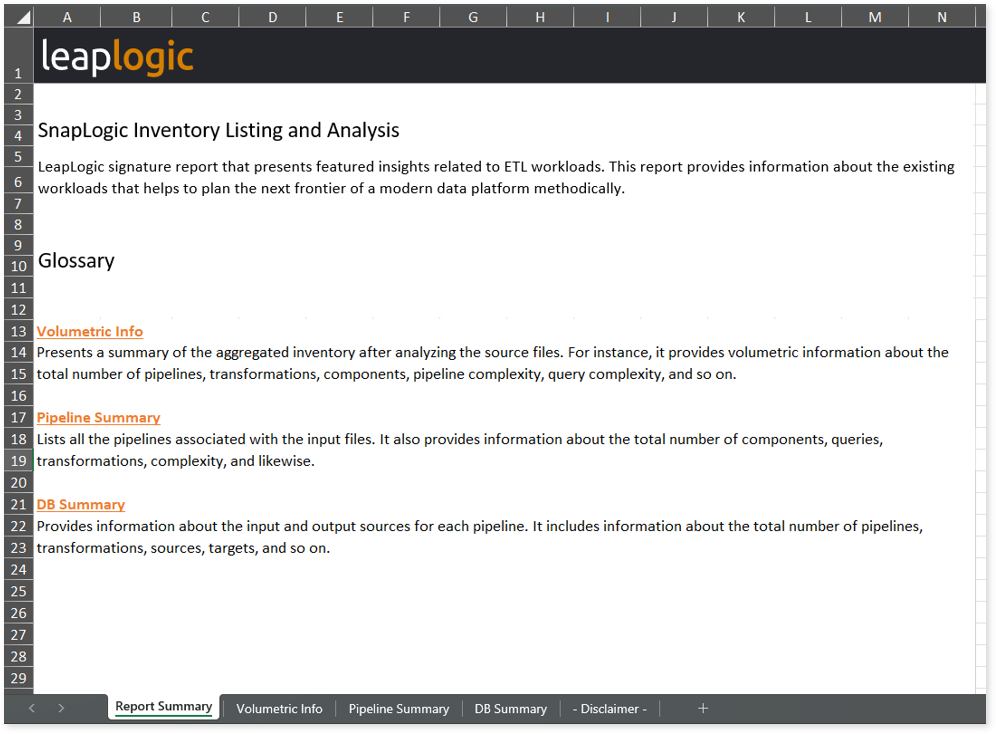
This report contains the following information:
- Report Summary: Provides information about all the generated artifacts.
- Volumetric Info: Presents a summary of the aggregated inventory after analyzing the source files. For instance, it provides volumetric information about the total number of pipelines, transformations, components, pipeline complexity, query complexity, and so on.
- Pipeline Summary: Lists all the pipelines associated with the input files. It also provides information about the total number of components, queries, transformations, complexity, and likewise.
- DB Summary: Provides information about the input and output sources for each pipeline. It includes information about the total number of pipelines, transformations, sources, targets, and so on.
Browse through the snaplogic folder to access snaplogic_query_details.csv file.
snaplogic_query_details.csv: This report provides information about queries including the used and impacted tables, analyzed status, complexity, and more. If the analyzed status is TRUE, it indicates that the query is analyzed successfully. Conversely, a FALSE status indicates that the query is not analyzed.

Source Inventory Analysis
It is an intermediate report which helps to debug failures or calculate the final report. It includes all the generated CSV reports.

keywordSearch.csv: Provides detailed insights into keyword occurrences— specifically pipelines—identified across all uploaded source files. It captures information such as the search type, the file where the keyword was found, the line number of occurrence, and the actual line content where the keyword appears.
The system dynamically extracts a specific list of keywords (Pipelines) from the pipeline_detail_snaplogic.csv assessment output report. These extracted keywords are then used to perform a case-insensitive search across all uploaded artifacts to help you to understand where specific pipelines are referenced.
license_quota_info.csv: This report provides information about the anticipated license quota deduction when executing a transformation pipeline or notebook using the same source input file that was used during the assessment. It includes details about the expected quota consumption for units, blocks, and scripts.

To access various outputs such as such as invalid_query.csv, Pipeline Detail Snaplogic.csv, Snaplogic Parse Component Detail.csv, Snaplogic Read Component Detail.csv, Snaplogic Write Component Detail.csv, and more, navigate through the etl > snaplogic folders.
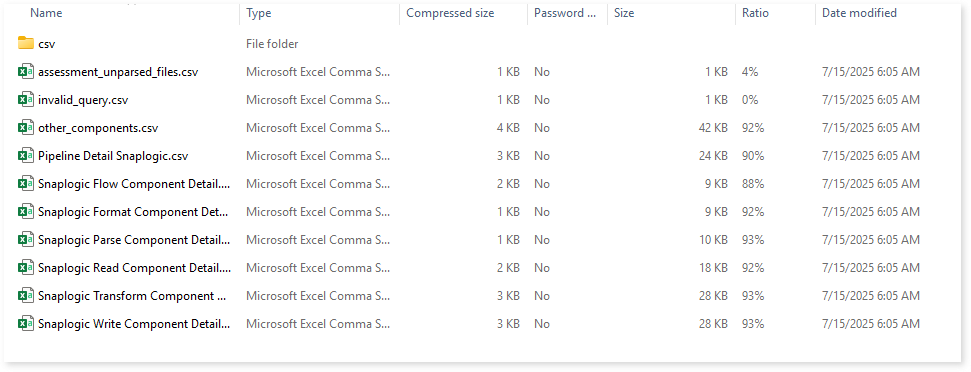
assessment_unparsed_files.csv: This report provides information about all the unparsed files along with the reason for parsing failure.
invalid_query.csv: This report lists all the invalid queries.
Pipeline Detail Snaplogic.csv: This report provides information about pipelines including information about components, component types, and more.
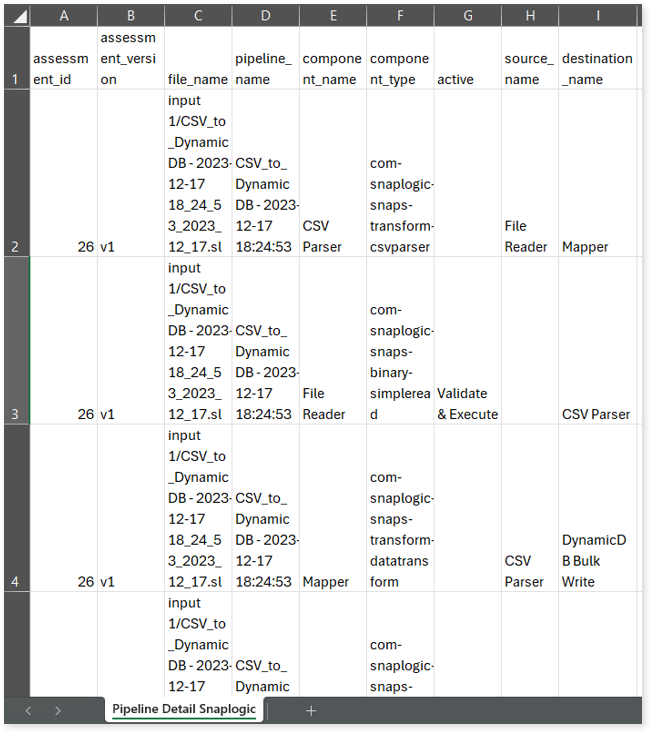
Snaplogic Parse Component Detail.csv: This report provides information about parse components.
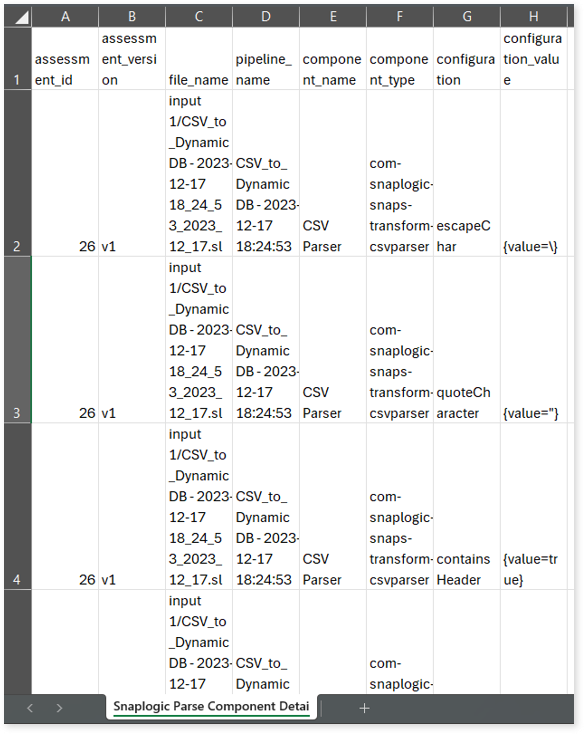
Snaplogic Read Component Detail.csv: This report provides information about read components.

Snaplogic Write Component Detail.csv: This report provides information about write components.
